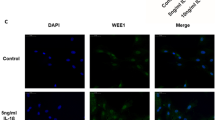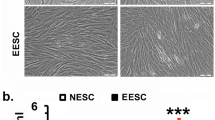Abstract
The activation of systemic and local inflammatory mechanisms, including elevated levels of chemokines and proinflammatory cytokines in endometriosis progression, is becoming more evident in the recent years. Here, we report the involvement of CXC chemokine 16 (CXCL16) and its sole receptor, CXC chemokine receptor 6 (CXCR6), in pathophysiology of endometriosis. Expression of CXCL16, but not CXCR6, was significantly upregulated in endometriotic lesions when compared to control endometrium. Additionally, serum CXCL16 was significantly elevated in women with endometriosis when compared to control group. Moreover, blockade of the CXCL16/CXCR6 axis by CXCR6 small-interfering RNA reduced the migration and invasion of ectopic endometrial stromal cells (EESCs) followed by decreased phosphorylation of ERK1/2. Furthermore, TNF-α treatment induced the expression of CXCL16 in EESCs. In conclusion, these results suggest that CXCL16/CXCR6 axis, whose expression was enhanced by TNF-α, may be associated with the increased motility of EESCs, through regulation of ERK1/2 signaling, thus contributing to the development of endometriosis. These findings indicate that the CXCL16/CXCR6 axis may contribute to the progression of endometriosis and could be served as a potential target for diagnosis and treatment.
Similar content being viewed by others
Reference
Giudice LC, Kao LC. Endometriosis. Lancet. 2004;364(9447):1789–1799.
Culley L, Law C, Hudson N, et al. The social and psychological impact of endometriosis on women’s lives: a critical narrative review. Hum Reprod Update. 2013;19(6):625–639.
Bulun SE. Endometriosis. N Engl J Med. 2009;360(3):268–279.
Lebovic DI, Mueller MD, Taylor RN. Immunobiology of endometriosis. Fertil Steril. 2001;75(1):1–10.
Weiss G, Goldsmith LT, Taylor RN, Bellet D, Taylor HS. Inflammation in reproductive disorders. Reprod Sci. 2009;16(2):216–229.
Ulukus M, Arici A. Immunology of endometriosis. Minerva Ginecol. 2005;57(3):237–248.
Akoum A, Lemay A, McColl S, Turcot-Lemay L, Maheux R. Elevated concentration and biologic activity of monocyte chemotactic protein-1 in the peritoneal fluid of patients with endometriosis. Fertil Steril. 1996;66(1):17–23.
Akoum A, Kong J, Metz C, Beaumont MC. Spontaneous and stimulated secretion of monocyte chemotactic protein-1 and macrophage migration inhibitory factor by peritoneal macrophages in women with and without endometriosis. Fertil Steril. 2002;77(5):989–994.
Ramey JW, Archer DF. Peritoneal fluid: its relevance to the development of endometriosis. Fertil Steril. 1993;60(1):1–14.
Wu M-Y, Ho H-N. The role of cytokines in endometriosis. Am J Reprod Immunol. 2003;49(5):285–296.
Iwabe T, Harada T, Tsudo T, et al. Tumor necrosis factor-alpha promotes proliferation of endometriotic stromal cells by inducing interleukin-8 gene and protein expression. J Clin Endocrinol Metab. 2000;85(2):824–829.
Eisermann J, Gast MJ, Pineda J, Odem RR, Collins JL. Tumor necrosis factor in peritoneal fluid of women undergoing laparoscopic surgery. Fertil Steril. 1988;50(4):573–579.
D’Antonio M, Martelli F, Peano S, Papoian R, Borrelli F. Ability of recombinant human TNF binding protein-1 (r-hTBP-1) to inhibit the development of experimentally-induced endometriosis in rats. J Reprod Immunol. 2000;48(2):81–98.
Barrier BF, Bates GW, Leland MM, Leach DA, Robinson RD, Propst AM. Efficacy of anti-tumor necrosis factor therapy in the treatment of spontaneous endometriosis in baboons. Fertil Steril. 2004;81(suppl 1):775–779.
Koizumi K, Hojo S, Akashi T, Yasumoto K, Saiki I. Chemokine receptors in cancer metastasis and cancer cell-derived chemokines in host immune response. Cancer Sci. 2007;98(11):1652–1658.
Luster AD. Chemokines‐‐chemotactic cytokines that mediate inflammation. N Engl J Med. 1998;338(7):436–445.
Struyf S, Proost P, Van Damme J. Regulation of the immune response by the interaction of chemokines and proteases. Adv Immunol. 2003;81:1–44.
Rossi D, Zlotnik A. The biology of chemokines and their receptors. Annu Rev Immunol. 2000;18:217–242.
Arici A, Tazuke SI, Attar E, Kliman HJ, Olive DL. Interleukin-8 concentration in peritoneal fluid of patients with endometriosis and modulation of interleukin-8 expression in human mesothelial cells. Mol Hum Reprod. 1996;2(1):40–45.
Ruiz A, Salvo VA, Ruiz LA, Báez P, García M, Flores I. Basal and steroid hormone-regulated expression of CXCR4 in human endometrium and endometriosis. Reprod Sci. 2010;17(10):894–903.
Hu W, Zhen X, Xiong B, Wang B, Zhang W, Zhou W. CXCR6 is expressed in human prostate cancer in vivo and is involved in the in vitro invasion of PC3 and LNCap cells. Cancer Sci. 2008;99(7):1362–1369.
Xiao G, Wang X, Wang J, et al. CXCL16/CXCR6 chemokine signaling mediates breast cancer progression by pERK1/2-dependent mechanisms. Oncotarget. 2015;6(16).
Hald SM, Kiselev Y, Al-Saad S, et al. Prognostic impact of CXCL16 and CXCR6 in non-small cell lung cancer: combined high CXCL16 expression in tumor stroma and cancer cells yields improved survival. BMC Cancer. 2015;15(1):11.
Jin J-J, Dai F-X, Long Z-W, et al. CXCR6 predicts poor prognosis in gastric cancer and promotes tumor metastasis through epithelial-mesenchymal transition. Oncol Rep. 2017;37(6):3279–3286.
Manabe S, Iwase A, Goto M, et al. Expression and localization of CXCL16 and CXCR6 in ovarian endometriotic tissues. Arch Gynecol Obstet. 2011;284(6):1567–1572.
Zhan H, Ma J, Ruan F, et al. Elevated phosphatase of regenerating liver 3 (PRL-3) promotes cytoskeleton reorganization, cell migration and invasion in endometrial stromal cells from endometrioma. Hum Reprod. 2016;31(4):723–733.
Gaetje R, Kotzian S, Herrmann G, Baumann R, Starzinski-Powitz A. Invasiveness of endometriotic cells in vitro. Lancet. 1995;346(8988):1463–1464.
Yu T, Wu Y, Helman JI, Wen Y, Wang C, Li L. CXCR4 promotes oral squamous cell carcinoma migration and invasion through inducing expression of MMP-9 and MMP-13 via the ERK signaling pathway. Mol Cancer Res. 2011;9(2):161–172.
Lin F, Chengyao X, Qingchang L, Qianze D, Enhua W, Yan W. CRKL promotes lung cancer cell invasion through ERK-MMP9 pathway. Mol Carcinog. 2015;54(Suppl 1): E35–E44.
McCawley LJ, Li S, Wattenberg EV, Hudson LG. Sustained activation of the mitogen-activated protein kinase pathway. A mechanism underlying receptor tyrosine kinase specificity for matrix metalloproteinase-9 induction and cell migration. J Biol Chem. 1999;274(7):4347–4353.
Abel S, Hundhausen C, Mentlein R, et al. The transmembrane CXC-chemokine ligand 16 is induced by IFN- and TNF- and shed by the activity of the disintegrin-like metalloproteinase ADAM10. J Immunol. 2004;172(10):6362–6372.
Khorram O, Taylor RN, Ryan IP, Schall TJ, Landers DV. Peritoneal fluid concentrations of the cytokine RANTES correlate with the severity of endometriosis. Am J Obstet Gynecol. 1993;169(6):1545–1549.
Borrelli GM, Carvalho KI, Kallas EG, Mechsner S, Baracat EC, Abrao MS. Chemokines in the pathogenesis of endometriosis and infertility. J Reprod Immunol. 2013;98(1–2):1–9.
Lu Y, Wang J, Xu Y, et al. CXCL16 functions as a novel chemotactic factor for prostate cancer cells in vitro. Mol Cancer Res. 2008;6(4):546–554.
Wagsater D, Hugander A, Dimberg J. Expression of CXCL16 in human rectal cancer. Int J Mol Med. 2004;14(1):65–69.
Gutwein P, Schramme A, Sinke N, et al. Tumoural CXCL16 expression is a novel prognostic marker of longer survival times in renal cell cancer patients. Eur J Cancer. 2009;45(3):478–489.
Wente MN, Gaida MM, Mayer C, et al. Expression and potential function of the CXC chemokine CXCL16 in pancreatic ductal adenocarcinoma. Int J Oncol. 2008;33(2):297–308.
Seidl H, Richtig E, Tilz H, et al. Profiles of chemokine receptors in melanocytic lesions: de novo expression of CXCR6 in melanoma. Human Pathol. 2007;38(5):768–780.
Maekawa M, Ishizaki T, Boku S, et al. Signaling from Rho to the actin cytoskeleton through protein kinases ROCK and LIM-kinase. Science. 1999;285(5429):895–898.
Chen T, Guo Z-P, Jiao X-Y, et al. Peoniflorin suppresses tumor necrosis factor-α induced chemokine production in human dermal microvascular endothelial cells by blocking nuclear factor-κB and ERK pathway. Arch Dermatol Res. 2010;303(5):351–360.
Chandrasekar B, Bysani S, Mummidi S. CXCL16 signals via Gi, phosphatidylinositol 3-kinase, Akt, I kappa B kinase, and nuclear factor-kappa B and induces cell-cell adhesion and aortic smooth muscle cell proliferation. J Biol Chem. 2004;279(5):3188–3196.
Author information
Authors and Affiliations
Corresponding author
Additional information
Author’s Note
Junyan Ma is co-first author on this work.
Rights and permissions
About this article
Cite this article
Peng, Y., Ma, J. & Lin, J. Activation of the CXCL16/CXCR6 Axis by TNF-α Contributes to Ectopic Endometrial Stromal Cells Migration and Invasion. Reprod. Sci. 26, 420–427 (2019). https://doi.org/10.1177/1933719118776797
Published:
Issue Date:
DOI: https://doi.org/10.1177/1933719118776797




